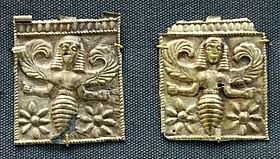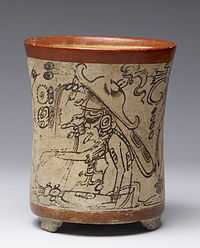Bee (mythology)

The bee, found in Ancient Near East and Aegean cultures, was believed to be the sacred insect that bridged the natural world to the underworld. Appearing in tomb decorations, Mycenaean tholos tombs were shaped as beehives.
Bee motifs are also seen in Maya cultures, an example being the Ah-Muzen-Cab, the Bee God, found in Maya ruins, likely designating honey-producing cities (who prized honey as food of the gods).
Worship

The bee was an emblem of Potnia, the Minoan-Mycenaean "Mistress", also referred to as "The Pure Mother Bee".[1] Her priestesses received the name of "Melissa" ("bee").[1] In addition, priestesses worshipping Artemis and Demeter were called "Bees".[2] The Delphic priestess is often referred to as a bee, and Pindar notes that she remained "the Delphic bee" long after Apollo had usurped the ancient oracle and shrine. "The Delphic priestess in historical times chewed a laurel leaf," Harrison noted, "but when she was a Bee surely she must have sought her inspiration in the honeycomb."[3][4] Ernst Neustadt, in his monograph on Zeus Kretigenes, "Cretan-born Zeus," devoted a chapter to the honey-goddess Melissa.
Myth
The Homeric Hymn to Apollo acknowledges that Apollo's gift of prophecy first came to him from three bee maidens, usually identified with the Thriae. The Thriae was a trinity of pre-Hellenic Aegean bee goddesses. The embossed gold plaque (illustration above right) is one of a series of identical plaques recovered at Camiros in Rhodes[5] dating from the archaic period of Greek art in the seventh century, but the winged bee goddesses they depict must be far older.
The Kalahari Desert's San people tell of a bee that carried a mantis across a river. The exhausted bee left the mantis on a floating flower but planted a seed in the mantis's body before it died. The seed grew to become the first human.
In Egyptian mythology, bees grew from the tears of the sun god Ra when they landed on the desert sand. The bowstring on Hindu love god Kamadeva's bow is made of honeybees.

The Baganda people of Uganda hold the legend of Kintu, the first man on earth. Save for his cow, Kintu lived alone. One day he asked permission from Ggulu, who lived in heaven, to marry his daughter Nambi. Ggulu set Kintu on a trial of five tests to pass before he would agree. For his final test Kintu was told to pick Ggulu's own cow from a stretch of cattle. Nambi aided Kintu in the final test by transforming herself into a bee, whispering into his ear to choose the one whose horn she landed upon.[6][7][8]
In Greek Mythology, Aristaeus was the god of bee-keeping. After inevitably causing the death of Eurydice, who stepped upon a snake while fleeing him, her nymph sisters punished him by killing every one of his bees. Witnessing the empty hives where his bees had dwelt, Aristaeus wept and consulted Proteus who then proceeded to advise Aristaeus to give honor in memory of Eurydice by sacrificing four bulls and four cows. Upon doing so, he let them rot and from their corpses rose bees to fill his empty hives.[9][10]
According to Hittite mythology, the god of agriculture, Telipinu, went on a rampage and refused to allow anything to grow and animals would not produce offspring. The gods went in search of Telipinu only to fail. Then the goddess Hannahannah sent forth a bee to bring him back. The bee finds Telipinu, stings him and smears wax upon him. The god grew even angrier and it wasn't until the goddess Kamrusepa (or a mortal priest according to some references) uses a ritual to send his anger to the Underworld.
Language
Both the Atharva Veda[11] and the ancient Greeks associated lips anointed with honey with the gift of eloquence: Achilles[12] and Pythagoras, it was said, had been fed on honey as infants, and the lips of Plato, Pindar,[13][14] and Ambrose of Milan were anointed with it.[15] The name "Merope" seems to mean "honey-faced" in Greek, thus "eloquent" in Classical times. Honey, "the gift of heaven" according to Virgil (Georgics, IV), even conveyed prescience: the priestess at Delphi was the "Delphic Bee", and in 1 Samuel 14 "Jonathan... put forth the end of the rod that was in his hand, and dipped it in a honey comb, and put his hand to his mouth; and his eyes were enlightened."
Beekeeping was a Minoan craft,[16] and the fermented honey-drink, mead, was an old Cretan intoxicant, older than wine.[17] The proto-Greek invaders, by contrast, did not bring the art of beekeeping with them. Homer saw bees as wild, never tame, as when the Achaeans issued forth from their ship encampment "like buzzing swarms of bees that come out in relays from a hollow rock" (Iliad, book II). For two thousand years after Knossos fell the classical Greek tongue preserved "honey-intoxicated" as the phrase for "drunken." The bee is also seen in a number of Aegean and Near Eastern names. The Jewish historian Josephus noted that the name of the poet and prophet Deborah meant "bee". The same root dbr gives "word", "indicating the bee's mission to give the Divine Word, Truth", observes Toussaint-Samat.[18] Melissa is also similarly defined.
Symbolism
In ancient Egypt, the bee was an insignia of kingship associated particularly with Lower Egypt, where there may even have been a Bee King in pre-dynastic times.[19] After the unification of Upper and Lower Egypt, this symbol was incorporated in the title usually preceding the throne name of pharaoh and expressing the unity of the two realms, He of the Sedge and of the Bee.
Honey bees, signifying immortality and resurrection, were royal emblems of the Merovingians, revived by Napoleon.[20] The bee is also the heraldic emblem of the Barberini. In heraldry, the bee symbolizes diligence and indefatigable effort. Someone is said to be busy as a bee when he or she works tirelessly and regardless of schedules or breaks.
A community of honey bees has often been employed by political theorists as a model of human society. This metaphor occurs in Aristotle and Plato; in Virgil[21] and Seneca; in Erasmus and Shakespeare and in Bernard Mandeville's Fable of the Bees, or Private Vices made Public Benefits,[22] which influenced Montesquieu and Marx. Tolstoy also compares human society to a community of bees in War and Peace.
See also
- Aristaeus and the bees, and their rebirth from an ox hide bougonia.
- Melissus of Crete
Notes
- ↑ 1.0 1.1 G.W. Elderkin (1939) "The Bee of Artemis"The American Journal of Philology 60' pp. 203-213
- ↑ Harrison 1922:442.
- ↑ Harrison 1922:442. See also Arthur Bernard Cook "The Bee in Greek Mythology" The Journal of Hellenic Studies 15 (1895), pp. 1-24.
- ↑ Melissa Delphis, according to Pindar's Fourth Pythian Ode, 60.
- ↑ One was illustrated in a line drawing in Harrison 1922:443, fig 135
- ↑ McLeish, Kenneth (1996). Bloomsbury Dictionary of Myth. Bloomsbury. ISBN 978-0-7475-2502-8.
- ↑ "Kintu the Person vs Kintu the Legend". Retrieved 19 April 2014.
- ↑ "Kintu - The First Human in Buganda". Retrieved 19 April 2014.
- ↑ McLeish, Kenneth (1996). Bloomsbury Dictionary of Myth. Bloomsbury. ISBN 978-0-7475-2502-8.
- ↑ "Aristaeus". Retrieved 20 April 2014.
- ↑ "O Asvins, lords of brightness, anoint me with the honey of the bee, that I may speak forceful speech among men! (Atharva Veda 91-258, quoted in Maguelonne Toussaint-Samat (Anthea Bell, tr.) The History of Food, 2nd ed. 2009:14.
- ↑ Chiron fed honeycomb to the young Achilles, according to Philostratus, Imagines ii.2.
- ↑ Philostratus, ii.12.
- ↑ Philostratus, Imagines ii. 12
- ↑ Toussaint-Samat 2009:16, 19.
- ↑ Haralampos V. Harissis, Anastasios V. Harissis. Apiculture in the Prehistoric Aegean.Minoan and Mycenaean Symbols Revisited. BAR S1958, 2009 ISBN 978-1-4073-0454-0 https://www.academia.edu/1259037/Apiculture_in_the_Prehistoric_Aegean._Minoan_and_Mycenaean_Symbols_Revisited
- ↑ Zeus made Cronus intoxicated with honey, "for wine was not", Nonnus wrote in Dionysiaca XIII.258.
- ↑ Toussaint-Samat 2009:18
- ↑ Rice, Michael, Egypt's Making: The Origins of Ancient Egypt 5000-2000 BC, 2nd ed., 2003, p 104.
- ↑ Eagle and the bee on the Napoleonic coat of arms
- ↑ Virgil, Georgics, book IV.
- ↑ Jean-Baptiste Simon titled his work of apiculture Le gouvernement admirable, ou, la république des abeilles (Paris, 1740).
References
- Cook, A.B. "The bee in Greek mythology" 1895 Journal of the Hellenic Society 15 pp 1ff, noted by Harrison 1922:443 note 1.
- Harrison, Jane Ellen, (1903) 1922. Prolegomena to the Study of Greek religion, third edition, pp 91 and 442f.
- Engels, David/Nicolaye, Carla (eds.), 2008, "Ille operum custos. Kulturgeschichtliche Beiträge zur antiken Bienensymbolik und ihrer Rezeption", Hildesheim (Georg Olms-press, series Spudasmata 118).
- James W. Johnson, "That Neo-Classical Bee" Journal of the History of Ideas 22.2 (April 1961), pp. 262–266.
- Haralampos V. Harissis, Anastasios V. Harissis. Apiculture in the Prehistoric Aegean.Minoan and Mycenaean Symbols Revisited. 2009. British Archaeological Reports S1958, ISBN 978-1-4073-0454-0
- Kerenyi, Karl 1976. Dionysos: Archetypal Image of Indestructible Life (Princeton: Bollingen Press)
- Neustadt, Ernst 1906. De Jove cretico, (Berlin). Chapter III "de Melissa dea" discusses bee-goddesses and bee-priestesses in Crete.
- Scheinberg, Susan 1979. "The Bee Maidens of the Homeric Hymn to Hermes" Harvard Studies in Classical Philology 83(1979), pp. 1–28.